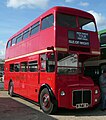Routemaster prototype RML3 / RM3
The bus was originally numbered RML3 to denote it as the 'Routemaster Leyland' prototype, although once production of the longer RML class began, RML3 was renumbered as RM3 (even though the production numbers of the RML class ran from RML880, numbered consecutively with the RM class).
As with all of the prototypes it had a different front end design to that used on the standard production buses. All four eventually gained a standard front much later during overhaul. In preservation, RM3 was restored to its original front end prototype appearance, and regained its RML3 number.
Uniquely, as the 'Routemaster Leyland', RML3 had a Leyland built pair of front and back underframes and engine (the Routemaster not having a conventional single-piece chassis) and a body built by Weymann. This did not result in any production orders for either company however, and all of the production examples (of all variants) followed the first two prototypes, RM1 and RM2, in having AEC frames and engines, and Park Royal bodywork (although a number of the production buses were built with Leyland engines on AEC frames).
The fourth prototype was RCL4, another Leyland but with unique Easter Coach Works bodywork and built as a prototype of the coach model of Routemaster ('Routemaster Coach Leyland'). Although RML3 was numbered as the third prototype, it was the last of the four to be completed. London Transport took it into stock on 1st July 1957 from Weymann. After being sent to Leyland for tests, in January 1985, registered as SLT 58, it was set to work on driver training and in service testing on route 8 / 8B. After just a year in this capacity it was involved in a collision with a lorry in Edgeware Road, damaging the front end. It did not re-enter service until March 1959. By November 1959 it was no longer required as a prototype vehicle (presumably as no orders were to be placed with Leyland/Weymann, and with RM production buses having started to go into service in from May 1959). From 1 November 1959 it was downgraded to an ordinary training bus. The renumbering to RM3 occured in September 1961.
Having been out of use since September 1963 (with parts being donated to keep RCL4 running), in 1965 it was overhauled, receiving the standard front end. RM3 was finally withdrawn as a trainer in April 1972, lastly allocated to Clapton (CT) garage.
Having been placed in storage, RM3 then became the first Routemaster to be preserved, being bought by the London Bus Preservation Group based at Cobham Bus Museum in Surrey. It arrived at the museum in February 1974.
Over 2003/4, RM3 was fitted with a replica of its original front end. With no original designs existing, and no original parts left due to the accident, the restoration relied on bespoke parts made using photographs taken during the accident repairs, and the original screw holes.
Restored to its original number, RML3, its first public appearance in this guise occured at the 50th Routemaster anniversary event, RM50, held in Finsbury Park in July 2004.In preservation[edit]
-
July 1979, Baker Street, London (as RM3 with standard front).
-
6 May 2007, HCVS Brighton to London run
-
2008 Isle of Wight Bus Museum running day


